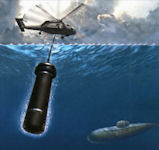AN/AQS-18 Dipping Sonar
 The AQS-18(V)-3 is the export version of the latest AQS-13F U.S. Navy helicopter-borne dipping sonar. The long-range active scanning sonar employs a transducer lowered into the water from a hovering helicopter to detect and maintain contact with underwater targets and to provide target classification clues. Active echo-ranging determines a target's range, bearing and opening or closing rate relative to the aircraft's position.
The AQS-18(V)-3 is the export version of the latest AQS-13F U.S. Navy helicopter-borne dipping sonar. The long-range active scanning sonar employs a transducer lowered into the water from a hovering helicopter to detect and maintain contact with underwater targets and to provide target classification clues. Active echo-ranging determines a target's range, bearing and opening or closing rate relative to the aircraft's position.
Incorporated into the AQS-18(V)-3 are sonar engineering advancements, including digital technology, improved signal processing, extensive use of hybrid integrated circuits and upgraded operator displays. The Adaptive Processor Sonar (APS) increases detection capabilities in shallow waters and reverberation-limited conditions, while essentially eliminating false alarms from the video display.The APS is a digital processor that uses Fast Fourier Transform techniques to provide a narrowband analysis of the uniquely shaped CW pulse, and to improve operation in non-reverberant conditions more typical of deep water.
The AQS-18(V)-3 dipping sonar is specifically designed for ASW helicopters which are often required to search in inherently difficult locations such as shallow water high-noise areas, coastal regions, constrained passages, high-density shipping lanes and areas of concentrated naval activity.
The AQS-18(V)-5 is a helicopter-borne dipping sonar. The long-range active scanning sonar employs a transducer lowered into the water from a hovering helicopter to detect and maintain contact with underwater targets and to provide target classification clues. Active echo-ranging determines a target's range, bearing and opening or closing rate relative to the aircraft's position.
Incorporated into the AQS-18(V)-5 are sonar engineering advancements, including digital technology, improved signal processing, extensive use of hybrid integrated circuits and upgraded operator displays. The Adaptive Processor Sonar (APS) increases detection capabilities in shallow waters and reverberation-limited conditions, while essentially eliminating false alarms from the video display. The APS is a digital processor that uses Fast Fourier Transform techniques to provide a narrowband analysis of the uniquely shaped CW pulse and to improve operation in non-reverberant conditions more typical of deep water.
The AQS-18(V)-5 dipping sonar is specifically designed for ASW helicopters which are often required to search in inherently difficult locations, such as shallow water high-noise areas, coastal regions, constrained passages, high-density shipping lanes and areas of concentrated naval activity.
The AQS-18A is a mid-frequency helicopter dipping sonar system designed for active, long-range search, localization and attack of submarines in both shallow and deep water environments. The sonar detects and maintains contact with underwater targets through a transducer lowered into the water from a hovering helicopter. Active echo-ranging determines the bearing, range and opening or closing rate of the target relative to the position of the helicopter.
The lightweight AQS-18A dipping sonar features long pulses, high source levels, FM capability, 16-beam signal processing, and a 20-nautical mile coverage range. The AQS-18A system is fully compatible with MIL-STD-1553B databus architectures to facilitate integration with aircraft subsystems and components. Interfaces are also provided to accept input data and provide graphic and data outputs to a sonic data recorder, as well as video for sensor data display.
The AQS-18A wet end consists of a small, high-density transducer assembly, a 440-meter cable and compatible reeling machine and dome control. The dry end consists of the sonar interface unit, cable interface power supply and sonar control unit. The sonar interface unit has powerful signal processing algorithms specifically designed for increased pulse lengths and spare processing space for additional processing features, such as computer-aided detection and classification, multi-sensor target fusion, embedded training and performance prediction (based on environmental data collected during past or current missions). The sonar control unit provides simple interface menus for operator command and control of the sonar system. Optional dry-end subsystems include a cable payout indicator, bearing-range indicator and multifunction display.
|
NEWSLETTER
|
| Join the GlobalSecurity.org mailing list |
|
|
|

